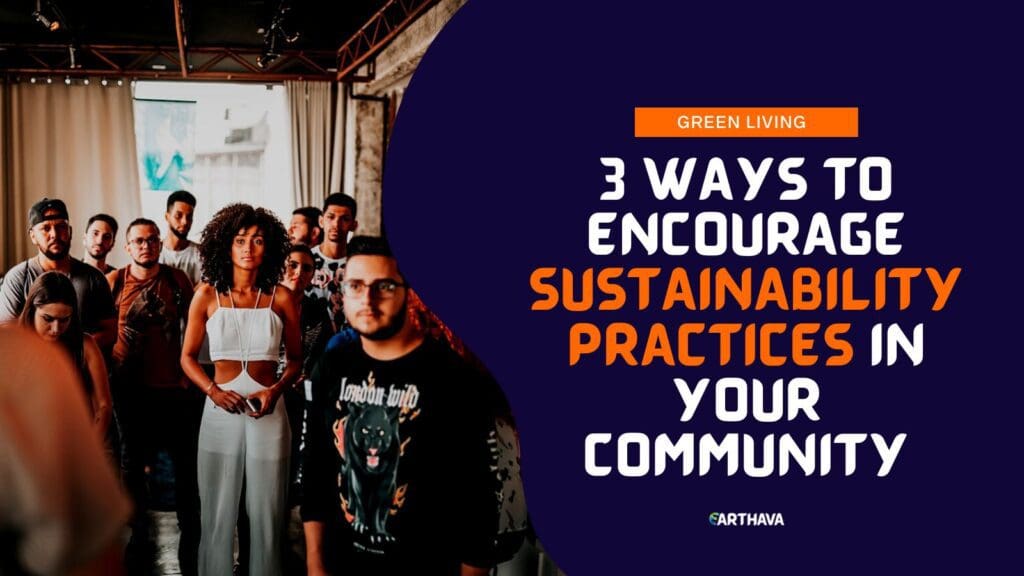Sustainability is a topic we can’t get away from. And we shouldn’t want to. Doing everything in our power to promote and sustain the planet’s health should be on all our to-do lists. Things are improving in this regard, with 51% of respondents in an IBM survey agreeing that environmental sustainability is more important to them today than it was a year ago. Still, we need more people to step up in their communities when it comes to promoting eco-consciousness. You can encourage your community to adopt sustainability practices in a few different ways, starting with what you do in your home.

Start With Your Home
You can’t be genuine about getting your community involved in sustainability initiatives if you don’t adopt eco-conscious habits yourself. In other words, practice what you preach regarding sustainability. Your household should be eco-friendly and so should your behaviors.
Start by replacing products with eco-friendly alternatives. For example, instead of incandescent lightbulbs, use LED ones. Instead of plastic bags, use recyclable or reusable bags. And use sustainable cleaning products instead of those ridden with chemicals.
Change your behaviors as well. For instance, save water by timing your showers, only running the dishwasher when it’s full, and refraining from letting the faucet run. You could also commit to using your garbage, compost, and recycling bins more appropriately. Or save energy by turning off lights in rooms you aren’t using and using space heaters.
It’ll be easier to make a case for the community to get more involved in sustainability if you can show them the benefits of doing so in your own life.
Choose Eco-friendly Transportation
“Greenhouse gas (GHG) emissions from transportation account for about 27 percent of total U.S. greenhouse gas emissions, making it the largest contributor of U.S. GHG emissions,” according to the United States Environmental Protection Agency (EPA).
The carbon dioxide released from burning fuels like gas and diesel is hazardous to our environment, causing Earth’s atmosphere to warm and initiate climate change. In addition, carbon dioxide can affect our health as constant exposure to it can lead to dizziness, headaches, increased heart rate, and difficulty breathing.
So, it’s crucial you move away from gas-powered vehicles and toward more eco-friendly transportation options and encourage your community to do the same. Here are a few to get you started.
Walking, biking, and skating
If you can get to where you’re going without a vehicle at all, do it. Walking, biking, running, skating, or another form of active transportation can help eliminate your contribution of harmful greenhouse gases to the environment. Your mental and physical health will benefit too.
Carpooling
As mentioned above, gas-powered cars aren’t good for the environment. The more we can take off the road, the better. That’s where carpooling can help. The environmental benefits of carpooling include reducing traffic congestion and the emission of harmful pollutants.
In addition, carpooling with neighbors can bring you closer together. You can socialize more often and get to know each other. And, hopefully, you can strengthen your movement to make your community more sustainable.
Public transportation
Public transportation is another great eco-friendly transportation option. It uses less energy and produces less pollution than if you travel in your own vehicle. You also have an opportunity to meet more people in your community and connect them to your sustainability initiatives.
Become the Lead Sustainability Advocate in Your Community
Somebody’s got to take the lead advocating for sustainability practices in your neighborhood. That someone is you. Becoming the lead sustainability advocate in your community doesn’t have to be grandiose. Instead, work on these core tasks.
Get Outside
To get people hooked on sustainability, show them the beauty of the outdoors. When people understand and feel how impactful nature can be, they’ll be more inclined to protect it.
For example, our mental and physical health benefits tremendously from nature. Spending time outdoors is proven to lower our stress levels, enhance focus, and encourage more physical activity. It’s also known to help us better manage symptoms of mental health conditions, like anxiety and depression.
So, get outside more with members of your community so that they can experience the benefits of nature and be inspired to protect it. This could look like this:
- Engaging in bird-watching with neighbors;
- Walking your dogs with others in the community;
- Encouraging neighbors to join you as you tend to your garden;
- Going on morning and evening walks on the neighborhood trails;
- Take your kids and neighbor kids to nearby parks.
Host sustainability meetings and events
If you want sustainability to become a priority in your community, you must ensure you’re always talking about it and promoting it.
Even better, consistently host sustainability meetings and events. You’ve got to keep it in your neighbors’ faces if you want them to absorb and adopt your sustainability initiatives.
Host a community sustainability meeting at least once a month. You can talk about your sustainability goals, why taking care of the environment is essential, and what you want to do to support eco-consciousness in the community.
Also, open up the conversation to everyone attending. Be sure they get their thoughts and ideas out as well. And leave every meeting with an actionable plan.
Furthermore, put on some fun sustainability events to get your community even more excited about bettering the health of our planet. For example, you could start a neighborhood recycling project. You could host a community garage sale. Or you could put on a dinner party for your entire neighborhood, with food made solely from the community garden.
Start a community garden
The FDA confirmed that 30 to 40% of the food supply in the United States becomes food waste. This means that 30 to 40% of our food ends up in our landfills — food that could’ve easily fed hungry families in your community and worldwide.
People could be wasting food for a variety of reasons. But we must acknowledge that many people don’t appreciate what it takes to grow food. There’s so much that happens before food ever hits the grocery store.
Teaching your community the behind-the-scenes of food production will help them appreciate food more, consume it more responsibly, and develop healthier production and waste practices.
You can do this through a community garden. Of course, starting a community garden will cost some money, and you’ll need to put serious effort into planning and to maintain it. But it’s worth it.
So, find out who’s interested in helping you with the garden, choose a location, gather supplies, and get started.
Conclusion
The sustainability conversation is getting more in-depth and more serious by the minute. The way our planet has taken care of us, it’s about time we extend the same care to it. With the tips above, you can start encouraging sustainability practices in your community today.


